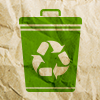It’s something we hear all the time. Our natural resources such as coal, oil and metals are dwindling, and the depletion of these resources destroys natural habitats. Despite the fact that many cities offer recycling programs to help combat this concern, people often feel recycling at home is more trouble than it’s worth. If you need a little more incentive to get into the habit, think about the fact that recycling also saves energy.
Recycling Benefits
 Walk around any store, and you are looking at products that took energy to produce them, particularly plastic and metal items. By using recycled materials, companies need less energy for production than making an item from scratch. Refining metal is a lengthy and expensive process and requires unbelievable amounts of water and petroleum.
Walk around any store, and you are looking at products that took energy to produce them, particularly plastic and metal items. By using recycled materials, companies need less energy for production than making an item from scratch. Refining metal is a lengthy and expensive process and requires unbelievable amounts of water and petroleum.
According to the EPA, using recycled aluminum only uses 5% of the energy and emissions that are needed to extract new aluminum. Even with the energy used to collect, process, and transport recycled materials, making products from them takes less energy because the materials have already undergone the inefficient initial processing. That’s simplifying a complicated scenario, but consider these recycling examples provided by the EPA and state energy agencies:
- Recycling 10 aluminum cans saves enough energy to power almost 52 hours of a laptop.
- Even recycling just ONE aluminum can saves enough energy to watch television for 3 hours.
- Recycling 1 plastic bottle a day for a month saves enough energy to power nearly 300 hours of a 60W CFL lightbulb.
- Recycling paper cuts energy usage in half. (America’s daily use of computer paper could go around the world 40 times!)
- Recycling a ton of glass saves the equivalent of nine gallons of fuel oil.
- Recycling one million laptops saves the energy equivalent to the electricity used by more than 3,500 US homes in a year. The next time you buy new electronics such as computers and cell phones, think of turning the old ones in to an electronics store for recycling.
Recycling at Home
 So what can you do to recycle at home? Start small, and think of how you can reduce the need to purchase new products. Reduce food waste by eating the food you have already and reusing jars and containers instead of buying more. Purchase food products in concentrate or bulk to reduce packaging waste, and look for products that are made with recycled materials. Instead of buying products like paper towels or dust wipes, reuse rags or old socks for cleaning.
So what can you do to recycle at home? Start small, and think of how you can reduce the need to purchase new products. Reduce food waste by eating the food you have already and reusing jars and containers instead of buying more. Purchase food products in concentrate or bulk to reduce packaging waste, and look for products that are made with recycled materials. Instead of buying products like paper towels or dust wipes, reuse rags or old socks for cleaning.
Check out the EPA’s Reduce, Reuse, and Recycle website for more home recycling tips. Or, take the next step and start recycling items that you would normally dump in the trash. To search for recycling locations near you, log onto RecyclerFinder.com.




